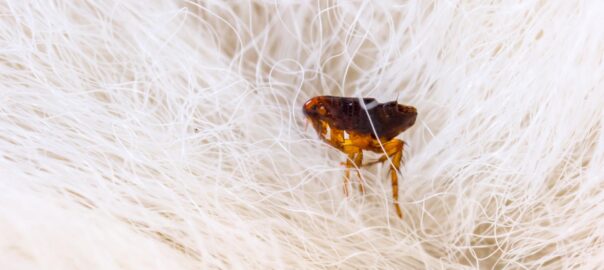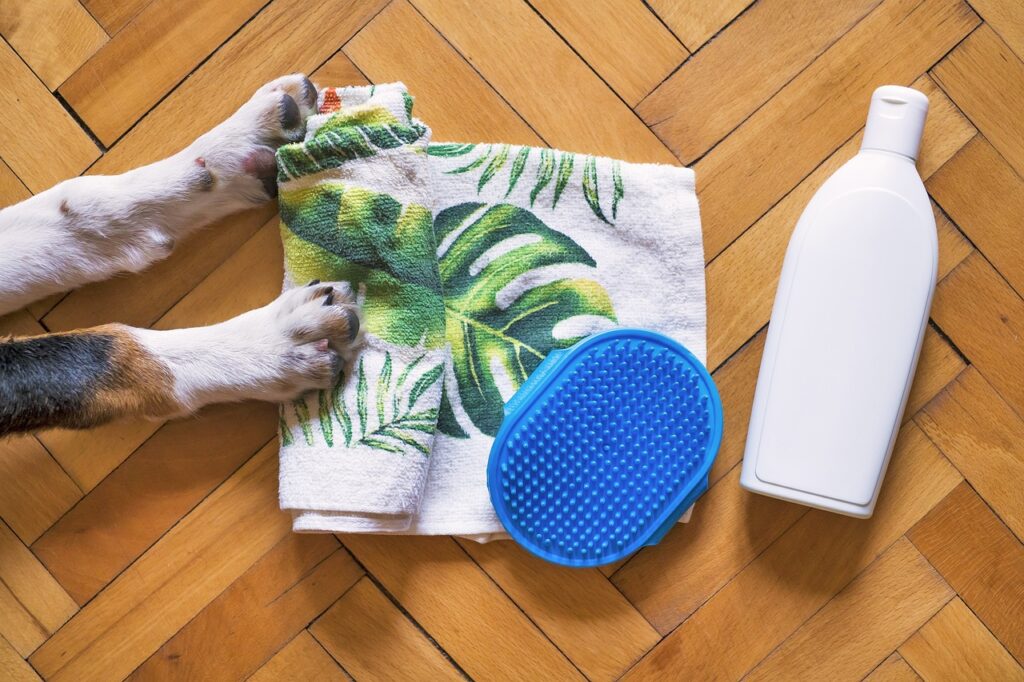Pet-Friendly Pest Control
- (541) 636-0146
- Schedule Service

Fleas are more than an itch-causing nuisance for you and your pets. They can affect your pet’s health and well-being and may cause health problems for you as well. With a moderate climate in Oregon, flea season can unfortunately extend throughout the year.
While these pests can pester you year-round, it doesn’t have to be that way! In this guide, learn key insights about fleas, including their peak activity periods and how you can mount an effective defense against these resilient parasites.
Fleas are small, flightless insects that survive as external parasites to mammals and birds. They’re wingless, but they’re extreme jumpers with the ability to jump 100 to 200 times their size. There are approximately 2,500 species of these jumping, blood-sucking, itch-inducing parasites.
What causes the bites to itch? When feeding, they release saliva containing an anticoagulant into your bloodstream, making it easier for them to feed. When they’re done, trace amounts of saliva are left on your skin. This is when your body kicks into action, releasing histamine that causes the bite to swell, resulting in the small red bump that is common with flea bites.
If the itching isn’t bad enough, fleas can actually make you or your pet sick. According to the Centers for Disease Control and Prevention (CDC), some fleas in the U.S. carry pathogens that can cause human disease, including plague, flea-borne (murine) typhus, cat scratch disease, and tapeworms.
When it comes to your dogs and cats, flea bites can cause skin irritation and swelling, and some pets can develop an allergic reaction to the bites. This can lead to hair loss or a bacterial skin infection.
Fleas have a pest expectancy or season. In western Oregon’s moderate climate, fleas can stick around all year, becoming most active during the warmer, humid months. Even during colder periods, indoor environments provide perfect conditions for these pests to thrive. This can pose a threat to your family and pets year-round.
Fleas are often found in carpets, furniture, crawlspaces, and your yard. They can also hijack their way into your home on shoes or on your loveable furbabies. Your pets can even pick up fleas from other animals around your yard, such as mice or squirrels.
What makes these pesky parasites so bad is that they have a short gestation period and are fully mature from between eight to 36 days. Adult flea females begin laying eggs 48 hours from their first feeding, which means that a flea infestation can spiral out of control fast.
Just like any creature, fleas have certain conditions they prefer. These parasites are most active in temperatures ranging from 70°F to 85°F, with a humidity level of 70%. In such conditions, a flea can complete its life cycle in as little as 18 days.
On the other hand, cold and dry environments slow down the flea’s life cycle and reduce their activity. Indoors, the warm, often humid homes provide the ideal environment for these pests, making them an all-year nuisance.
Fleas are most active at dawn and dusk, coinciding with the activity periods of their preferred hosts (cats, dogs, and other mammals). During these times, they’re on a feeding and breeding frenzy, making them a serious pest.
Oregon’s diverse climate makes it an interesting case for flea activity. With its milder temperatures and higher humidity, the western region is an almost year-round playground for fleas.
Flea activity can significantly reduce during the colder months in regions like the Central Oregon plateau or mountainous areas, where winters can be harsh. This leads to a surge in the spring when temperatures start to climb again, continuing well into late fall.
However, remember that indoors in Oregon, particularly in heated buildings, which create a warm, stable environment, fleas bustle about year-round. So, nobody gets a free pass! A year-round, preventative approach to flea control is something all residents should consider.
Recognizing flea infestations earlier is key to managing and eliminating these pesky parasites from your life. Knowing what signs to look for can save a lot of discomfort for both you and your pets and prevent a more troublesome infestation. Let’s take a look at some of these signs:

Keep an eye on your pets during flea season. If your pet is scratching more than usual, or if you notice adult fleas or eggs on their skin, it’s highly likely that you’re dealing with fleas. Other signs of fleas in pets could include unexplained hair loss, unusual restlessness, or even signs of anemia in severe infestations.
Fleas won’t hesitate to feast on humans if they find an opportunity. Look out for itchy red bites, often around your ankles—a surefire sign of fleas. Also, beware of tiny black droppings or flea dirt. These are flea feces composed of undigested blood, a less well-known but equally revealing sign of a flea infestation.
Fleas don’t restrict their activity to living beings. They can infest your home surroundings, too. If you spot flea eggs in your carpets or adult fleas in your house, that’s a clear indication of an infestation. Flea eggs are tiny, white, about a millimeter long, and are often found in clusters on carpets, pet’s bedding, or other places your pets frequent.
Remember, early detection can help curb a flea infestation before it takes over. So, stay vigilant to keep these annoying critters at bay.

When discovering a flea problem, you might want to run to the store and stock up on all the bug bombs you can find. Or you might search the Internet for home remedies and DIY sprays. While these might appear appealing, they’re rarely as effective as one might hope (you can read why here).
Flea pupae can remain dormant for months, waiting for the right conditions to emerge. That’s why many infestations seem to reoccur shortly after treatment. Bug bombs, sprays, and home remedies might help to a degree, but rarely do they address these dormant pupae, leading to a potential resurgence of the infestation.
This is where the professionals can help. Bug Zapper Pest Control can help you win the battle against biting fleas with our flea control services. Before we get started, there are a few things you can do as we work together to oust the fleas from your home:

While fleas can be tricky to get rid of due to their life cycle, complete flea elimination isn’t a pipe dream. It can be accomplished quickly with the help of trained professionals who know how to use the right products in the right way, along with a multi-tiered management plan for fleas.
We’re here to help! Contact us to schedule flea relief for your pets and family. We also have services to eliminate fleas outside with our permanent pest removal service.



